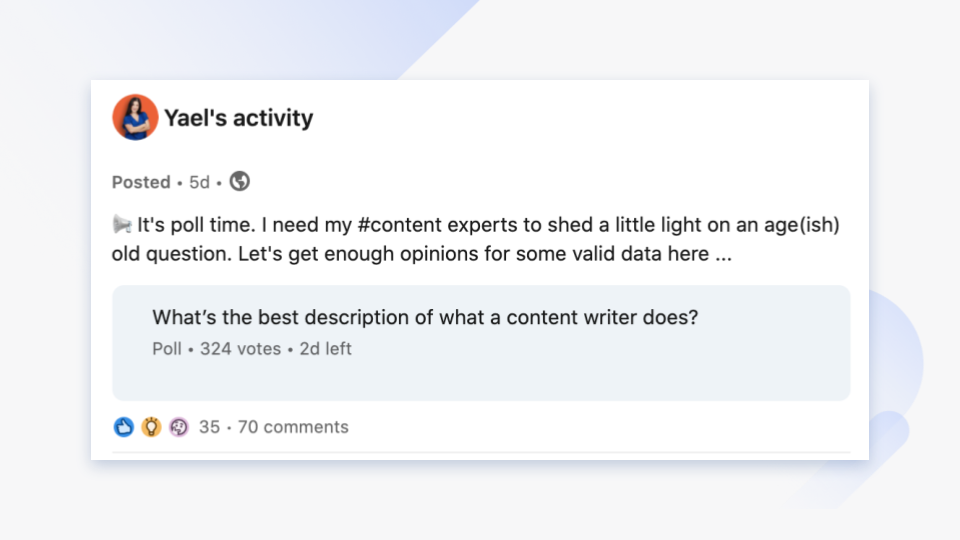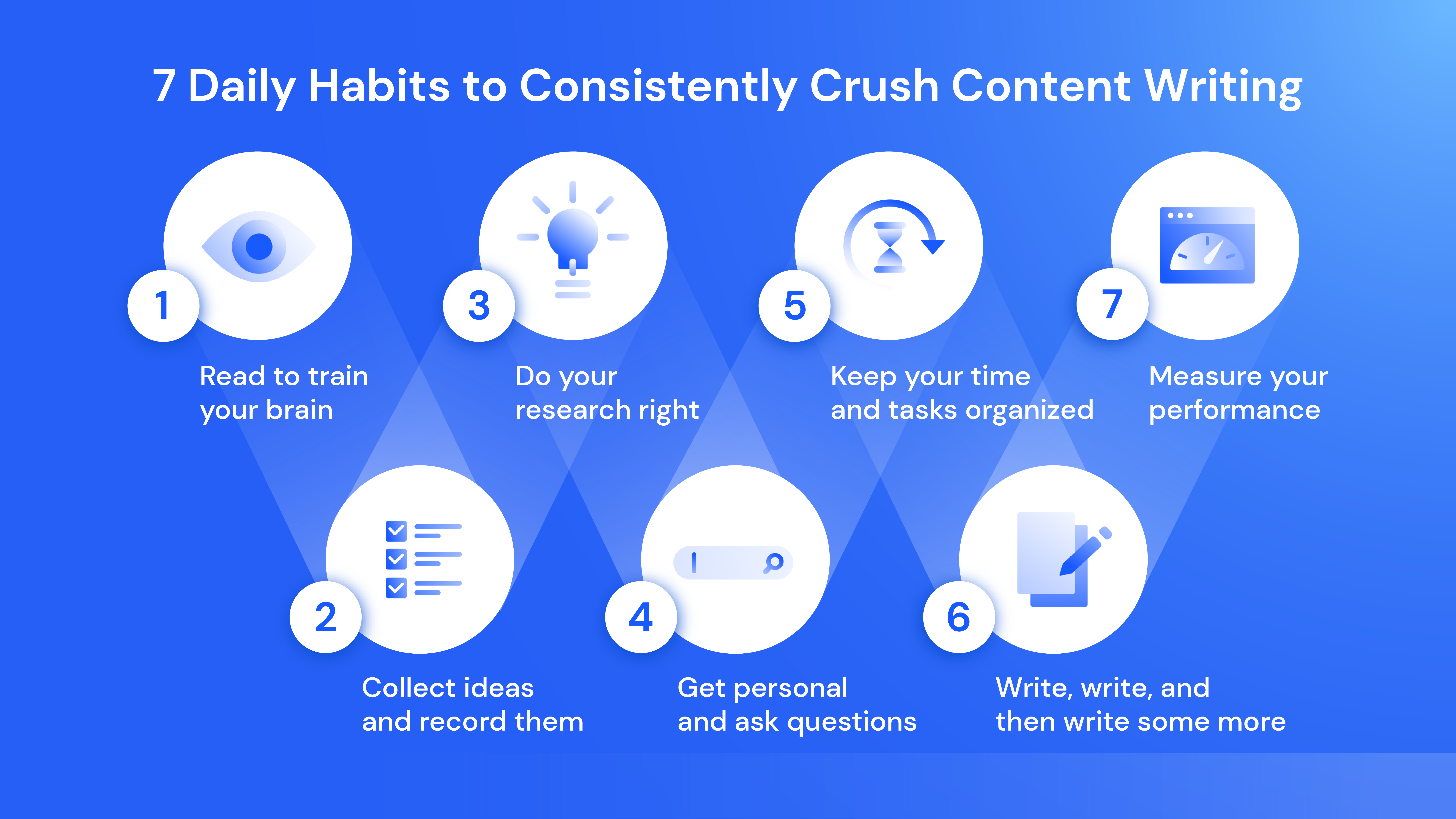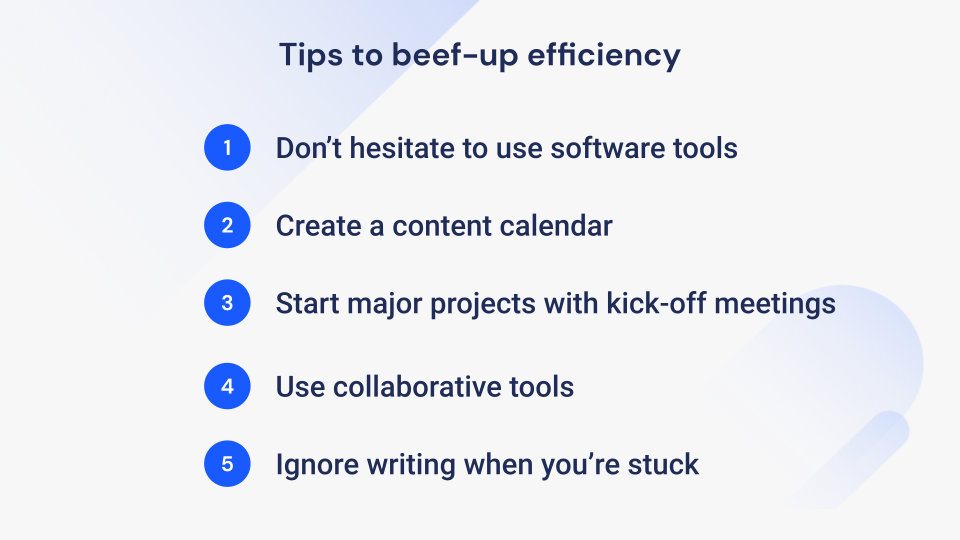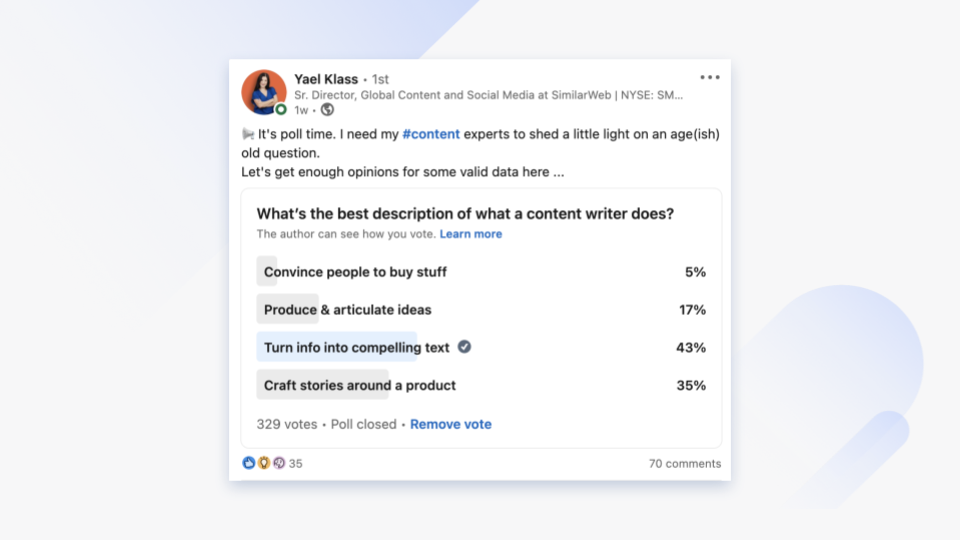My content and social media team is growing – and fast.
With these changes comes an avalanche of strategic and logistical tasks requiring constant attention.
Through it all, I find myself returning to the same basic philosophical questions about the true value and core goals of content.
To get out of my own head and tap into the wisdom of the masses, I created a poll on Linkedin, asking: What’s the best description of what a content writer actually does?
These were options:
- Convinces people to buy stuff.
- Produces ideas and articulates them.
- Turns information into compelling texts.
- Crafts stories around a product.
 Screenshot from Linkedin, November 2021
Screenshot from Linkedin, November 2021Here’s a little food for thought: Writers need to wear many hats to create excellent content continuously – emphasis on continuously.
Continuity is the meat and potatoes, the keystone, the bottom line, the… okay, you get it.
Businesses don’t have time to wait for spontaneous outbursts of creativity or the luxury of pushing deadlines when writers’ block hits.
Content needs to operate like a well oiled-machine, run by writers. How do you produce high-value writing that drives real impact day in and day out?
I’ll walk you through 7 daily habits that I swear by. And at the end of the post, I’ll reveal the survey results.
7 Daily Habits To Consistently Crush Content Writing
 Image by Author, November 2021
Image by Author, November 20211. Read To Train Your Brain
Just like an athlete needs to keep their muscles in shape with interval training, writers need to read – all the time.
That’s why the first must-have item on every writer’s daily to-do list is to read.
Just read.
I’m not here to recommend specific books, or authors, or blogs. Sorry to disappoint, but the thing is that reading keeps your brain in top shape.
Think about it. Naturally, your thoughts aren’t made up of sentences but of images, feelings, sounds, numbers, associations, and words.
When you sit down in front of your computer screen, you must mold all that into language in a way that grabs attention. Reading is the key to keeping your writing fresh.
And when I say read, I mean anything from Vice to the washing machine instructions.
Okay, maybe that’s a little far out.
But seriously, the idea is to get familiar with the most compelling ways to express a thought and transmit information in words.
And find your content crushes.
Content crushes can come in the form of fiction, emails, or PPC ads that pop up while you’re scrolling. They’re any type of content that inspires you to be better.
How do you find them?
- Read fiction. Inspire your creativity, get storytelling ideas, and enrich vocabulary.
- Read reports. Discover new ways to deliver information clearly.
- Read marketing content. Subscribe to random newsletters, sales emails, and pay attention to marketing copy.
Read books on writing.
Follow writers’ blogs and sign-up for their mailing lists.
- Read market leaders’ and industry-related influencers’ content. Stay in the know about trends and buzzwords.
- And the list goes on.
But how do you hold onto those amazing new ideas?
2. Collect Ideas And Record Them
In marketing, randomly reading stuff on the net during work hours is, well, totally recommended. To scale up your writing, make sure to be productive while you do that.
I’ll tell you how: Have two files open – a swipe file and a scrap file.
In the swipe file, you collect any outstanding ads, headlines, banners, pieces of content, or whatever made you go: “Wow, what a great idea!”
After all, that’s what you are constantly required to do, right? Come up with fresh and unique ideas.
Even the most successful writers don’t permanently pull brilliant sentences out of their hats on demand. They often go back to their library of other people’s great work (a.k.a., the swipe file) to get inspiration.
Equally important is jotting down your own ideas.
These little buggers tend to sprout up in the weirdest moments. But when you need them, they’re nowhere to be found.
So, here’s what you do: You keep a scrap file where you can scribble down or record whenever you think of something that could come in handy.
3. Do Your Research Right
Now, let’s not get carried away browsing. I get it; you love language and could spend the entire day dissecting other people’s writing and making it better.
Me too. But if you want to be successful, you’ve got to remain hyper-focused on your impact (and getting things done).
You need to hone in on the subject matter of your writing projects and ensure you’re set to tell an in-depth story from start to finish. Begin by finding material about the topic, the industry, or the product you need to cover.
See what others in the industry publish, which topics they address, and what language they use.
Here’s a trick I love: I find the most popular keywords in an industry or category using the keyword research tool from Similarweb, the company I work for.
Then I check which terms drive the most traffic to close competitors (I can do that with my company’s tool, as well) and see where else Google sends me.
For pure SEO assignments, I read the articles that rank highest for relevant search terms – bet you didn’t think of this one yourself. I check the structure, the message, and the professional level of the articles.
Doing this regularly helps create content that gets read. Excellent content also needs accuracy and uniqueness – cue my next point.
 Screenshot from Similarweb, November 2021
Screenshot from Similarweb, November 20214. Get Personal And Ask Questions
No amount of reading or Googling can replace the input you get from the people on the inside.
That includes the people with professional knowledge.
Let’s say you write about design, go talk to a designer at your company. When you write to promote your business’s new software feature, ask the developers what makes it unique.
You may dig up some fascinating detail that will turn your content into an aha experience for readers.
Always ask questions. You need absolute clarity to create relatable content for your readers, which means you sometimes have to nudge.
Be gentle and don’t overdo it, though.
Your other best friends are sales reps and customer service personnel.
They have a unique understanding of the issues that concern customers and how the staff deals with them. You might stumble upon some golden nuggets to expand on or just get ideas on how to approach your assignment.
5. Keep Your Time And Tasks Organized
Did you realize that up to now, all you’ve done is collect info? Oh, and ideas.
That’s a lot of raw material to handle, so you better get organized, especially with your time.
Plan how much you can invest in each of the above. I find that I need to set a limit for some activities so I don’t lose track of time.
For others, I need to set a reminder so I don’t neglect them. The trick is finding what works for you.
That’s why one of the most important tasks to set time apart for is your administrative stuff. I know. We writers do our best work in a bubble. But there are earthly matters that need daily attention. Like emails.
Whether you are a freelancer or an in-house writer, there’s always email correspondence to keep up with. If you fall behind, you miss critical updates or even changes in projects. You may lose out on promising opportunities.
 Image by Author, November 2021
Image by Author, November 20216. Write, Write, Write, And Then Write Some More
You’ve been waiting for this one, haven’t you? It’s so obvious, though, I almost left it out.
But then, I didn’t want you to think I’m a fraud, telling you to be a great writer without writing every day?
Truth is, the best advice you can get from anyone is to develop a daily writing routine.
But you know that already. So how about you do more and really have fun with it? Create training exercises for yourself by adding some funky challenges to the practice.
What do I mean?
For example: Write as many words as you can in ten minutes. Ignore grammar and spelling. Just write as fast as you can.
Crazy? Maybe. Do this several times, and you’ll realize that your sentence structure is improving and your ideas are becoming clearer.
Want some more bizarre activities?
- Come up with at least 300 headlines for the same article.
- Try to keep a specific sentence structure throughout a 200-word text.
- Write the same information in five different tones and styles.
There are endless exercises you can do to sharpen your skills and refine your thinking.
7. Measure Your Performance
If numbers scare you, you aren’t alone. Measuring the performance of your content doesn’t need to be complex.
In digital marketing, data determines business, meaning there are measurable goals attached to your words: drive traffic, generate leads, advance conversion, etc.
If you leave the numbers game to the analysts, how can you get the answers you need? Analysts care about their own goals.
Monitor engagement with your blog posts over time. Ask questions like:
- How much time do they spend reading a post?
- When do people read your posts?
- How do they reach your posts?
- Does the actual audience match your target audience?
- Which topics get spontaneous attention, and which are evergreens?
Do the same with other types of content and don’t skip the A/B testing.
When you believe your content is excellent because you think it’s authentic, funny, and engaging, that’s a trap. It could be amazing, but it could also be your ego. You are starting to fall in love with your own style.
Nothing wrong with that, but it doesn’t pay the bills. Customers do.
Get behind the performance data of your content and discover what they like, and stay on top of shifting trends.
And here’s a little secret: that’s the best way to keep learning and continuously mastering content writing assignments.
What About Creativity?
Do I hear someone grumbling in the back: “All that routine stuff is a creativity killer?”
Here’s my take on this: If you want to be creative, your brain needs to be free of distraction.
Routine helps you concentrate on one thing at a time and not do everything at once. Create a routine for all the necessary tasks so they won’t creep up on you when trying to be creative.
It’s necessary to provide the proper brain food and steer your thoughts in the right direction.
Do you see where this is heading? These seven habits are related to what you put in to get the desired output. And they help you create your mental creativity bubble.
You’re right, though; you also need a can-do feeling. Many writers I know listen to music while writing; others need a stack of their favorite snacks in reach.
Whatever gets your creative juices flowing and helps you concentrate.
Bonus Tips To Beef-Up Efficiency
It’s all about producing creativity – or maybe creating productivity?
Regardless, it’s a process that requires efficiency. Let me share with you a few tips that work well for my team and I.
Don’t hesitate to use software tools.
A tool like Evernote is excellent for recording ideas. Project management tools such as Asana, or monday.com are super easy to handle and can truly make your life easier.
Hemingway and Grammarly help with proofreading.
Try Brain.fm for music – apropos creative bubble.
Create a content calendar.
It’s a fantastic method to keep track of projects and to plan ahead without any, ‘Oops, we forgot to do a campaign for Thanksgiving.’
Start major projects with kick-off meetings that include all stakeholders.
This helps align expectations and avoid misunderstandings. The purpose is to set clear goals, KPIs and determine the workflow.
Remember, you are the one to ask the unpleasant questions because if they remain unanswered, it backfires on you.
Use collaborative tools.
If you are working in a team, or even just with one or two others, like G Suite or Sharepoint. Content goes through many stages, and that’s the only way to keep everyone on the latest version and avoid chaos.
My personal secret:
You will get stuck sometimes when you write. Every writer does.
The best way to handle it is not to fight it.
Get up, run on the treadmill or around the block, do some yoga, whatever physical activity gives you the kicks.
Make sure to forget about writing for a while and then come back to it. Exercise is great to reset your thoughts and send the blood flowing through your brain.
And if sports aren’t your thing, another creative activity can also do the trick.
 Image by Author, November 2021
Image by Author, November 2021The True Challenge
That’s a wrap on my list for a solid writer’s routine. Now I owe you the outcome of the poll. You didn’t think I’d forget, did you?
 Screenshot from Linkedin, November 2021
Screenshot from Linkedin, November 2021To me, all the answers are correct, and I could come up with a bunch of additional definitions that all make sense.
For some content types, you need more storytelling; for others, you need to focus on simplifying information. You always need to come up with ideas, and you always need to monitor results.
Wherever your focus is, the challenge to continuously maintain excellence in content is the same.
Persistence is my recipe, and I encourage my team to stick to the daily habits when creating content for our blog (or any other content, for that matter – but the blog’s my baby).
More Resources:
- 3 Top Skills SEO Content Writers Need to Succeed
- 19 Daily Habits That Make You Less Productive (And What to Do)
- Content Marketing: The Ultimate Beginner’s Guide
Featured image: Shutterstock/Roman Samborskyi





